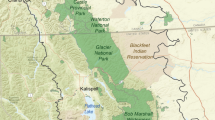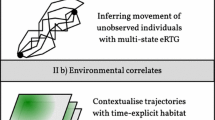Abstract
We discuss how to construct models for cluster point processes within ‘territories’ modelled by \(d\)-dimensional Voronoi cells whose nuclei are generated by a latent Poisson process (where the planar case \(d=2\) is of our primary interest). Conditional on the territories/cells, the clusters are independent Poisson processes whose points may be aggregated around or away from the nuclei and along or away from the boundaries of the cells. Observing the superposition of clusters within a bounded region, we discuss how to account for edge effects. Bayesian inference for a particular flexible model is discussed in connection to a botanical example.










Similar content being viewed by others
References
Baddeley B, Møller J (2000) Non- and semi-parametric estimation of interaction in inhomogeneous point patterns. Stat Neerl 54:329–350
Baddeley A, Turner R (2005) Spatstat: an R package for analyzing spatial point patterns. J Stat Softw 12:1–42
Barr C, Schoenberg FP (2010) On the Voronoi estimator for the intensity of an inhomogeneous planar Poisson process. Biometrika 97:977–984
Blackwell PG (2001) Bayesian inference for a random tessellation process. Biometrics 57:502–507
Blackwell PG, Møller J (2003) Bayesian analysis of deformed tessellation models. Adv Appl Probab 35:4–26
Byers SD, Raftery AE (2002) Bayesian estimation and segmentation of spatial point processes using Voronoi tilings. In: Lawson AG, Denison DGT (eds) Spatial cluster modelling. Chapman & Hall/CRC Press, London
Cox DR (1955) Some statistical models related with series of events. J R Stat Soc B 17:129–164
Deutsch JL, Deutsch CV (2014) A multidimensional scaling approach to enforce reproduction of transition probabilities in truncated plurigaussian simulation. Stoch Environ Res Risk Assess 28:707–716
Foss SG, Zuyev SA (1996) On a Voronoi aggregative process related to a bivariate Poisson process. Adv Appl Probab 28:965–981
Geyer CJ, Møller J (1994) Simulation procedures and likelihood inference for spatial point processes. Scand J Stat 21:359–373
Gilks WR, Richardson S, Spiegelhalter DJ (1996) Markov chain Monte Carlo in practice. Chapman & Hall, London
Heikkinen J, Arjas E (1998) Non-parametric Bayesian estimation of a spatial Poisson intensity. Scand J Stat 25:435–450
Juan P, Mateu J, Saez M (2012) Pinpointing spatio-temporal interactions in wildfire patterns. Stoch Environ Res Risk Assess 26:1131–1150
Miles RE (1971) Isotropic random simplices. Adv Appl Probab 3:353–382
Møller J (1989) Random tessellations in \({\mathbf{R}}^{d}\). Adv Appl Probab 21:37–73
Møller J, Rasmussen JG (2012) A sequential point process model and Bayesian inference for spatial point patterns with linear structures. Scand J Stat 39:618–634
Møller J, Waagepetersen RP (2004) Statistical inference and simulation for spatial point processes. Chapman and Hall/CRC, Boca Raton
Møller J, Waagepetersen RP (2007) Modern spatial point process modelling and inference (with discussion). Scand J Stat 34:643–711
Okabe A, Boots B, Sugihara K, Chiu SN (2000) Spatial tessellations: concepts and applications of Voronoi diagrams, 2nd edn. Wiley, Chichester
Ramesh NI, Thayakaran R, Onof C (2013) Multi-site doubly stochastic Poisson process models for fine-scale rainfall. Stoch Environ Res Risk Assess 27:1383–1396
Skare Ø, Møller J, Jensen EBV (2007) Bayesian analysis of spatial point processes in the neighbourhood of Voronoi networks. Stat Comp 17:369–379
Tsai FTC (2010) Bayesian model averaging assessment on groundwater management under model structure uncertainty. Stoch Environ Res Risk Assess 24:845–861
Acknowledgments
Supported by the Danish Council for Independent Research|Natural Sciences, grant 12-124675, “Mathematical and Statistical Analysis of Spatial Data”, and by the Centre for Stochastic Geometry and Advanced Bioimaging, funded by a grant from the Villum Foundation.
Author information
Authors and Affiliations
Corresponding author
Appendices
Appendices
1.1 Appendix 1: Proof of Theorem 1
Let the situation be as in Sect. 2. By the Slivnyak-Mecke Theorem (Møller and Waagepetersen (2004) and the references therein), \(M\) is equal to
which by stationarity of \({\mathbf{Y}}\) can be rewritten as
where \(W_{\rm ext}^c={\mathbb{R}}^{d}\setminus W_{\rm ext}\) is the complement of \(W_{\rm ext}\) and \(W_{-y}\) is \(W\) translated by \(-y\). Note that \(C(o;{\mathbf{Y}} \cup \{o\})\) is the so-called typical Poisson–Voronoi cell (see e.g. (Møller (1989))). Denoting \(T\) the distance from \(o\) to the furthest vertex of \(C(o;{\mathbf{Y}} \cup \{o\})\) and \(d(o,W_{-y})\) the distance from \(o\) to \(W_{-y}\) (which is well-defined if e.g. \(W_{-y}\) is compact),
is an upper bound for (12) and hence also for \(p\).
In order to bound (13), we start by deriving a lower bound on the cumulative distribution function (cdf) of \(T\). Denote \(\sigma _d=2\pi ^{d/2}/\Gamma (d/2)\) the surface area of the unit ball in \({\mathbb{R}}^{d}\), and \(F_{d}\) the cdf of the Gamma-distribution with shape parameter \(d\) and scale parameter 1.
Lemma 1
If \(W\) is compact, then
Proof of Lemma 1: We shall ignore nullsets. With probability one, for all pairwise distinct points \(y_1,\dots ,y_d\in {\mathbf{Y}}\), the \(d\)-dimensional closed ball \(B(o,y_1,\dots ,y_d)\) containing \(o,y_1,\dots ,y_d\) in its boundary is well-defined. Denote \(R(o,y_1,\dots ,y_d)\) the radius of \(B(o,y_1,\dots ,y_d)\). Then \({\rm P}(T>t)\) is at most
where \(\not =\) over the summation sign means that \(y_1,\dots ,y_d\) are pairwise distinct, and noting that the sum is almost surely \(d!\) times the number of vertices in \(C(o;{\mathbf{Y}}\cup \{o\})\) with distance at least \(t\) to \(o\). Therefore, by repeated use of the Slivnyak-Mecke theorem, \({\rm P}(T>t)\) is at most
and hence, since \({\mathbf{Y}}\) is a stationary Poisson process and \(B(o,y_1,\dots ,y_d)\) has volume \(\omega _dR(o,y_1,\dots ,y_d)^{d}\), \({\rm P}(T>t)\) is at most
where \(A\subset {\mathbb{R}}^{d}\) is an arbitrary Borel with volume \(0<|A|<\infty \), and where \(R=R(y_0,y_1,\dots ,y_d)\) is the radius of the \(d\)-dimensional closed ball \(B(y_0,y_1,\dots ,y_d)\) containing \(y_0,y_1,\dots ,y_d\) in its boundary (which is well-defined for Lebesgue almost all \((y_0,y_1,\dots ,y_d)\in {\mathbb{R}}^{d(d+1)}\)). Denote \(z=z(y_0,y_1,\dots ,y_d)\) the centre of \(B(y_0,y_1,\dots ,y_d)\), \(u_i=u_i(y_0,y_1,\dots ,y_d)\) the unit vector such that \(y_i=z+Ru_i\) (\(i=0,1,\ldots ,d\)), \(\Delta (u_0,u_1,\ldots ,u_d)\) the volume of the convex hull of \(u_0,u_1,\ldots ,u_d\), and \(\nu \) surface measure on the unit sphere in \({\mathbb{R}}^{d}\). Then, by Blasche-Petkantschin’s formula (e.g. Miles (1971)), \({\rm P}(T>t)\) is at most
which reduces to
Thereby, since
and
(see Theorem 2 in Miles (1971)), we obtain (14) after a straightforward calculation.
Proof of Theorem 1: It suffices to consider the case where \(W=b(z,r_1)\). Then \(p\) is at most
where the inequality follows from Lemma 1. Hence, using Fubini’s theorem, a shift for \(y\) to hyperspherical coordinates in \({\mathbb{R}}^{d}\), and the fact that \(\omega _d=\sigma _d/d\), we easily deduce the result.
1.2 Appendix 2: Moment results
Since \({\mathbf{X}}\) is a Cox process driven by (2), moment results for \({\mathbf{X}}\) are inherited from the distribution of the primary point process \({\mathbf{Y}}\). In particular, \({\mathbf{X}}\) has intensity \(\rho ={\rm E}\varLambda (o)\) and pair correlation function \(g(x)={\rm E}\left[ \varLambda (o)\varLambda (x)\right] /\rho ^2\), \(x\in {\mathbb{R}}^{d}\) (provided these expectations exist), see e.g. Møller and Waagepetersen (2004). This appendix discusses the expressions of \(\rho \) and \(g\).
Recall the notion of the typical Voronoi cell: Let \(\Pi \) denote the space of compact convex polytopes \(C\subset {\mathbb{R}}^{d}\) with \(|C|>0\) and \(o\in {\rm {int}}C\) (we equip \(\Pi \) with the usual \(\sigma \)-algebra for closed subsets of \({\mathbb{R}}^{d}\) restricted to \(\Pi \), i.e. the \(\sigma \)-algebra generated by the sets \(\{C\in \Pi :C\cap K=\emptyset \}\) for all compact \(K\subset {\mathbb{R}}^{d}\)).
The typical Voronoi cell is a random variable \({\mathcal{C}}\) with state space \(\Pi \) and distribution
where \(B\subset {\mathbb{R}}^{d}\) is an arbitrary (Borel) set with \(0<|B|<\infty \) (by stationarity of \({\mathbf{Y}}\), the right hand side in (15) does not depend on the choice of \(B\)). Intuitively, \({\mathcal{C}}\) is a randomly chosen cell viewed from its nucleus; formally, (15) is the Palm distribution of a Voronoi cell. It follows by standard measure theoretical considerations that
for any nonnegative (measurable) function \(f\), and letting \(\mathcal A=|{\mathcal{C}}|\), then \({\rm E}\mathcal A=1/\kappa \). See e.g. (Møller (1989)).
Since \({\mathbf{Y}}\) is a stationary Poisson process, by the Slivnyak-Mecke formula (see e.g. Møller and Waagepetersen (2004)),
for any nonnegative (and measurable) function \(f\). By (16)-(17) and stationarity of \({\mathbf{Y}}\), we can then take
Proposition 1
If \({\rm E} k(\mathcal A)<\infty \), then
is finite.
Proof
By (2),
Combining this with (16) and the facts that \(\rho ={\rm E}\varLambda _{\rm ext}(o)\) and \(|C_i|=|C_i-y_i|\), we obtain that \(\rho \) is equal to
whereby the assertion follows.
The pair correlation function \(g\) is more complicated to evaluate. For example, let \(k\) be the identity function. Then by similar arguments as in the proof of Proposition 1 and by using (17) and (18), we obtain
Here the first mean value corresponds to the case where two secondary points with locations \(o\) and \(x\) belong to the same cell, and the second mean value corresponds to the case where they belong to two different cells. We are not aware of any analytic methods for evaluating these mean values, even if \(h(\cdot ;C)\) is uniform on \(C\), in which case
where the integrals may be evaluated by numerical methods.
Rights and permissions
About this article
Cite this article
Møller, J., Rasmussen, J.G. Spatial cluster point processes related to Poisson–Voronoi tessellations. Stoch Environ Res Risk Assess 29, 431–441 (2015). https://doi.org/10.1007/s00477-014-0914-3
Published:
Issue Date:
DOI: https://doi.org/10.1007/s00477-014-0914-3




